The Gardens are brimming with history but some absolute gems are hidden in plain sight. Some you might walk past without even spotting, whilst others give a tantalising glimpse into the remains of the past 200 years of history. Today we’re going to take in some sights you might not even have realised you were seeing.
We’re going to start today at the The Games Bunker near the entrance to X -Sector and take the path that leads towards Dark Forest, amongst the trees you find on this path is:
1. The King’s Tree
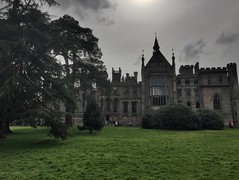 Whilst most of the trees you find around the Towers were planted during the period when the Earls were laying out the Gardens at Alton Towers, some are more recent.
Whilst most of the trees you find around the Towers were planted during the period when the Earls were laying out the Gardens at Alton Towers, some are more recent.
One of the cedars on the front lawn, for example, was reputedly a gift from King Edward VII to mark his visit to the Towers in 1907.
Two thirds of the way along the path, you’ll come to a path on your left. Turn towards the White bridge that acts as the main entrance of the Gardens. Pause as you head under the bridge to look at the plaque on the wall:
2. He Made the Desert Smile Again
 At first glimpse you might be forgiven for thinking the plaque is directly quoting the nearby Choragic Monument, which pays tribute to Charles Talbot, who first had the vision for the Gardens in the valley.
At first glimpse you might be forgiven for thinking the plaque is directly quoting the nearby Choragic Monument, which pays tribute to Charles Talbot, who first had the vision for the Gardens in the valley.
But here we have a twist on the famous quote from the monument as a tribute to Dennis Bagshaw, who managed Alton Towers in the years before it became an amusement park and is credited with taking the gardens into their second golden age through significant restoration, care and attention in the years after the war.
Pass under the bridge and take the first left along the Scalloped Wall and you’ll soon come to a trough featuring the:
3. Talbot Hound Fountain
 The Talbot Hound has a long standing connection to the Earls of Shrewsbury and the breed of hunting dog is likely named after John Talbot, the first Earl. A pair of the hounds feature on the family’s coat of arms, but the breed was most likely already extinct by the time the Earls arrived at Alton Towers.
The Talbot Hound has a long standing connection to the Earls of Shrewsbury and the breed of hunting dog is likely named after John Talbot, the first Earl. A pair of the hounds feature on the family’s coat of arms, but the breed was most likely already extinct by the time the Earls arrived at Alton Towers.
This is not the only Talbot Hound around the park, another example can be found at the entrance of Hex, where a pair stand guard at the former grand entrance to the Towers. Alton Towers much loved mascot, Henry Hound, was also said to be descended from the Talbot Hounds.
Continue along the path until you reach the Dutch Gardens on your left and don’t take a look at:
4. The Missing Lions
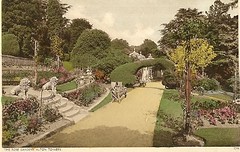 For many years a pair of lions stood guard at the entrance of the Dutch Garden, as seen in this postcard. It is not unusual for statues to have moved around the gardens over the past 200 years; especially after the war, during which it seems many of the statues were put into storage and may not have found their way back to their original homes for many years. The lions have now been replaced by a pair of statues that were likely to have been part of the original design for the garden.
For many years a pair of lions stood guard at the entrance of the Dutch Garden, as seen in this postcard. It is not unusual for statues to have moved around the gardens over the past 200 years; especially after the war, during which it seems many of the statues were put into storage and may not have found their way back to their original homes for many years. The lions have now been replaced by a pair of statues that were likely to have been part of the original design for the garden.
If you want to see the lions themselves you might have to wait a couple of weeks until the Resort is fully open again, since they are now found inside the entrance to the Alton Towers Hotel.
Carry on down the path and under the Yew Arch, take the path to your left between the arch and the conservatory and head behind the building to discover
5. The Pottery Studio
 It is easy to get distracted by the grandeur of the Conservatories themselves, but a walk along the back of the building is a walk through another slice of the garden’s history. The buildings along the back of the conservatories are where potters would craft their wares from the 1950s through to the 1990s, when they moved to the Farmyard.
It is easy to get distracted by the grandeur of the Conservatories themselves, but a walk along the back of the building is a walk through another slice of the garden’s history. The buildings along the back of the conservatories are where potters would craft their wares from the 1950s through to the 1990s, when they moved to the Farmyard.
Over the years the buildings of the Grand Conservatories have also contained a shop and for many years a tea rooms for guests to take the weight off as they explored the Gardens.
Walk to the end of the building and then turn left up the steps and you’ll find yourself at:
6. The Lawn of the Broken Columns
 Not an official title, but this intriguing little lawn is surrounded by the ruins of a long forgotten feature that would no doubt once have delighted the earls and their guests.
Not an official title, but this intriguing little lawn is surrounded by the ruins of a long forgotten feature that would no doubt once have delighted the earls and their guests.
With nearly 200 years under its belt the gardens are filled with memories of the past and whilst this one is fairly obvious as you pass by, if you keep an eye on the undergrowth as you walk around you can sometimes spot the remains of the garden’s past splendour.
The route veers to the left and soon hits the main path, turn right and you’ll shortly come to a crossroads, one corner of which is home to:
7. The Gunner’s Cottage
 There are three houses to be found within the Gardens, which once would have been home to employees of the Earl and later park staff. The name suggests that this cottage would have once been home to the estate’s gamekeeper.
There are three houses to be found within the Gardens, which once would have been home to employees of the Earl and later park staff. The name suggests that this cottage would have once been home to the estate’s gamekeeper.
Of all the houses in the park, the Gunner’s Cottage was the last to be lived in and was still occupied until the early 2000s.
Turn right at the crossroads and you’ll soon come to the:
8. The Gardener’s Cottage
 When the Towers first opened as a pleasure park, this cottage acted as a tea room and its large patio was filled with tables of guests enjoying afternoon tea. It ceased to be a tea room in the 1960s and the owner of the cottage would later sometimes operate a shop from the premises.
When the Towers first opened as a pleasure park, this cottage acted as a tea room and its large patio was filled with tables of guests enjoying afternoon tea. It ceased to be a tea room in the 1960s and the owner of the cottage would later sometimes operate a shop from the premises.
In the 1980s the house was converted into three flats, which were rented out to park staff and the property was last occupied in the mid 90s. More recently you might recognise the building from the promos for the House of Monsters, which were shot at the cottage.
Continue along the path and you’ll soon come to the edge of the Gardens, continue into Mutiny Bay and you’re at:
9. The Park Railway Station
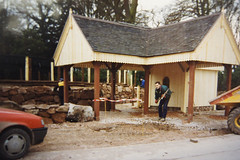 We’re about half way through our walk, so it’s the perfect time to grab a snack and nowhere could be better in the context than Pirate Treats.
We’re about half way through our walk, so it’s the perfect time to grab a snack and nowhere could be better in the context than Pirate Treats.
This building was originally constructed as one of the stations for the Park Railway. Our picture shows the station under construction in the early 90s.
Once you’ve purchased any refreshments you need retrace your steps and enter The Haunted Hollow also known as:
10. Quixhill Drive
Talking of the Park Railway, you are now walking along The Haunted Hollow, which follows the route of the former railway line. The ride’s tracks were built along the former road known as Quixhill Drive, which in the earls’ days was one of the main carriage routes to the Towers.
Don’t get distracted by the Tomb in the early part of the walk and you might spot one of the milestones built into the walls, which would have once let travellers know they were nearing the house.
At the end of the walled section of the path, if you take a look through the trees to the right you might spot the back of the Gardener’s Cottage and to the left the remains of The Flume.
Walk the entire length of The Haunted Hollow and then continue towards the Skyride station so you come out at the Gothic Prospect Tower, which sits atop:
11. Thompson’s Rock and the Bear Cave
 The Gothic Temple was one of the 15th Earl’s favourite features due to its amazing views across the Gardens to the Towers, as seen in this etching from 1869. Indeed the bust that is today located in the Choragic Monument was originally located in front of the tower, with the Earl looking out across his creation.
The Gothic Temple was one of the 15th Earl’s favourite features due to its amazing views across the Gardens to the Towers, as seen in this etching from 1869. Indeed the bust that is today located in the Choragic Monument was originally located in front of the tower, with the Earl looking out across his creation.
The outcrop the Prospect Tower is built on is known as Thompson’s Rock and as you descend the steps, the more formal stonework gives way to natural stone. In the rocks to your left you will see a cave where a black bear was once kept. Once upon a time guests could get scarily close to the bear and in 1857 it is said that the bear bit off the hand of once guests when she got too close.
After the bear died, he was later stuffed and put on display in the house (he was later sold with much of the rest of the house contents).
Passing the cave, turn right at the end of the path and then turn left when you reach the Corkscrew Fountain. Keep going until you come to the Yew Tree Walk, which was once known as:
12. The Golden Gate Walk
 The carved posts at this end of the walk once supported a pair of ornate gates, which can be seen at the edge of this pre-war postcard.
The carved posts at this end of the walk once supported a pair of ornate gates, which can be seen at the edge of this pre-war postcard.
The gates separated the formal gardens from the Rock Walk, which starts behind you, and were distinctive enough to provide one of the many names for this part of the garden.
Pass through the gate posts and turn right before the first arch. Head down the steps to:
13. La Refuge
 One of the best know ‘hidden’ features of the garden, this ornamental Bath Fountain was once used as a plunge pool, which satisfied a Victorian health craze of taking cold baths throughout the year. La Refuge acted as a changing room for the pool and on either side of the door are a pair of vents, one for air circulation and the other a chimney.
One of the best know ‘hidden’ features of the garden, this ornamental Bath Fountain was once used as a plunge pool, which satisfied a Victorian health craze of taking cold baths throughout the year. La Refuge acted as a changing room for the pool and on either side of the door are a pair of vents, one for air circulation and the other a chimney.
It is said that the frontage of La Refuge was originally part of the Towers themselves but were moved to the Gardens during one of the refurbishments in the mid-1800s.
Head along the Colonnade of the Muses and turn right down the steps at the end. In front of you is :
14. The Bandstand
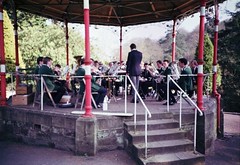 Not at all hidden, but of interest as one of the few significant structures added to the gardens after the time of the Earls of Shrewsbury.
Not at all hidden, but of interest as one of the few significant structures added to the gardens after the time of the Earls of Shrewsbury.
The company that purchased the Towers in the 20s largely maintained the gardens as they were, but the Bandstand was added during the 20s as a new music venue, which was subsequently used right through to the 1990s. Our photos shows a band performing in the late 80s.
Pass between the Canal and Bandstand and walk down the steps opposite. At the bottom turn right and continue towards:
15. The Pagoda Fountain
 You might not realise it due to the sheer height of the water shooting 70ft into the air, but the Pagoda Fountain is actually operated by gravity.
You might not realise it due to the sheer height of the water shooting 70ft into the air, but the Pagoda Fountain is actually operated by gravity.
We’re used to seeing concept artwork for rides, but pictured we can see a concept for the fountains from the 1800s. If this plan had come to the pass the fountain, which is based on the To-Ho Pagoda in Canton, would have been twice as high as the structure we see today.
Pass between the Pagoda Fountain and the neighbouring Dolphin Lake and find the steps about half way along the Pagoda Fountain’s lake. Follow the steps up and take the second right, at the top of these steps you are on the edge of:
16. Slain Hollow
 What theme park would be complete without its own battleground? You are now on the edge of Slain Hollow, which runs down to the River Churnet and is reputedly the site of a battle between King Ceolred of Mercia, who occupied the Bunbury Hillfort that was once located on the site of the Towers, and King Ina of Wessex, who set up camp further down the valley along the Rock Walk.
What theme park would be complete without its own battleground? You are now on the edge of Slain Hollow, which runs down to the River Churnet and is reputedly the site of a battle between King Ceolred of Mercia, who occupied the Bunbury Hillfort that was once located on the site of the Towers, and King Ina of Wessex, who set up camp further down the valley along the Rock Walk.
As you might expect there’s not much to be seen in the hollow, although the Earl’s influence extends deep into the valley, where carved rock arches such as this one can still be found.
Turn right at the top of the steps and head along the path and keep and eye on the left side of the path and you’ll soon pass below
17. The Swiss Cottage Patio
 The Swiss Cottage only gained its outdoor patio in the 1980s, but the retaining wall is much older. And for stonework enthusiasts the style of this wall might look familiar to anyone who has spent time in Fountain Square.
The Swiss Cottage only gained its outdoor patio in the 1980s, but the retaining wall is much older. And for stonework enthusiasts the style of this wall might look familiar to anyone who has spent time in Fountain Square.
These bricks once made up the wall that split the Towers’ entrance plaza from the neighbouring garden, as seen in this post-war postcard. The wall was demolished and rebuilt as the Swiss Cottage patio in the early 80s to make way for the long since departed Railcar Restaurant.
Continue up the path and eventually you’ll leave the gardens. You are now at the end of the path on which you started your walk.
If you want to continue your stroll, you are now at the start of our Walk in the Past guided walk.
If not, turn left and head towards Mutiny Bay. You’ll pass over the White Bridge and are walking between the Boating Lake and the Gardens on a path that have previously been used as a:
18. Raceway
 During the 50s and 60s Alton Towers would often play host to motor racing meets, which were highly popular days in the park’s calendar.
During the 50s and 60s Alton Towers would often play host to motor racing meets, which were highly popular days in the park’s calendar.
At that time, many of the paths we see in the park today were not yet pedestrianised and the roads that loop around the Boating Lake served as the raceway for these meets. As seen in this picture taken during one of the races, the raceway included the incredibly narrow White Bridge, which is only just wide enough for a car at the best of times.
Our tour in the park is at an end but if you want to see one more piece of Alton Towers that is hidden in plain sight then you might want to take a detour on the way home.
From the main vehicle entrance of the park, turn right and double back on yourself onto Wooton Lane (you may have previously taken this route after a fireworks evening). Part way along the lane changes to Waste Lane but you want to follow it to the very end and then turn right onto Westhouse Lane.
At the crossroads continue straight over onto Marlpit Lane and continue to the end of the road before turning right onto the B5032 (Quixhill Lane). These directions can also be found on Google Maps.
Continue down Quixhill Lane for 1.5 miles and on your right you will come to:
Bonus: Quixhill Lodge
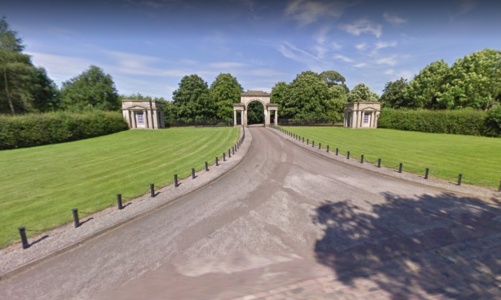 Earlier on your walk you walked along one end of Quixhill Drive, which today is The Haunted Hollow. Welcome to the other end.
Earlier on your walk you walked along one end of Quixhill Drive, which today is The Haunted Hollow. Welcome to the other end.
The gates in front of you were once one of the formal entrances to the Alton Towers estate and the carriageway beyond was designed to wow visitors with a first impression that would build from here until eventually The Towers themselves would be revealed at the other end.
It is not possible to follow the Quixhill Drive today as the land is now owned by several different parties, but it enters Alton Towers just behind the treehouses in the Enchanted Village and then follows what is now the Woodland Walk into the park.
Safe journey home!

